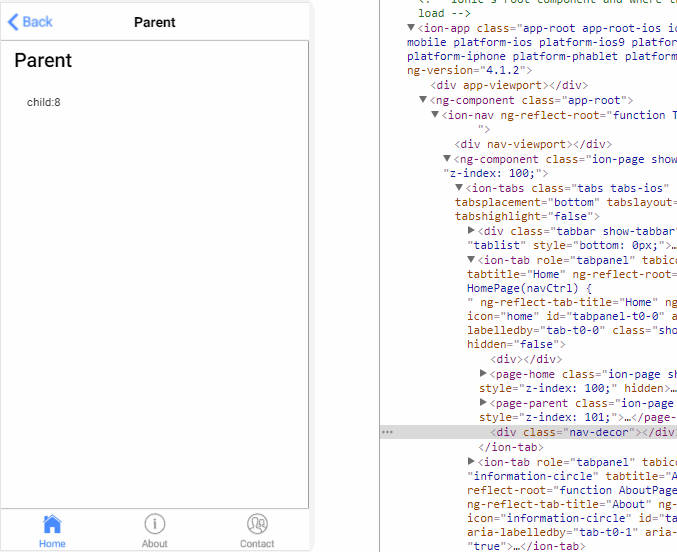Angular4 组件通讯方法大全
组件通讯,意在不同的指令和组件之间共享信息。如何在两个多个组件之间共享信息呢。
最近在项目上,组件跟组件之间可能是父子关系,兄弟关系,爷孙关系都有。。。。。我也找找了很多关于组件之间通讯的方法,不同的方法应用在不同的场景,根据功能需求选择组件之间最适合的通讯方式。下面我就总结一下关于组件通讯的N多种方法。
1.父→子 input
parent.ts
import { Component } from '@angular/core';
@Component({
selector: 'page-parent',
templateUrl: 'parent.html',
})
export class ParentPage {
i: number = ;
constructor() {
setInterval(() => {
this.i++;
}, )
}
}
parent.html
<ion-header>
<ion-navbar>
<ion-title>Parent</ion-title>
</ion-navbar>
</ion-header> <ion-content padding>
<h2>Parent</h2>
<page-child [content]="i"></page-child>
</ion-content>
child.ts
import { Component,Input } from '@angular/core';
@Component({
selector: 'page-child',
templateUrl: 'child.html',
})
export class ChildPage {
@Input() content:string;
constructor() {
}
}
child.html <ion-content padding>
child:{{content}}
</ion-content>
结果:

2.子→父 output
parent.ts
import { Component } from '@angular/core';
@Component({
selector: 'page-parent',
templateUrl: 'parent.html',
})
export class ParentPage {
i: number = ;
numberIChange(i:number){
this.i = i;
}
}
parent.html
<ion-header>
<ion-navbar>
<ion-title>Parent</ion-title>
</ion-navbar>
</ion-header> <ion-content padding>
<h2>Parent:{{i}}</h2>
<page-child (changeNumber)="numberIChange($event)"></page-child>
</ion-content>
child.ts
import { Component, EventEmitter, Output } from '@angular/core';
@Component({
selector: 'page-child',
templateUrl: 'child.html',
})
export class ChildPage {
@Output() changeNumber: EventEmitter<number> = new EventEmitter();
Number: number = ;
constructor() {
setInterval(() => {
this.changeNumber.emit(++this.Number);
}, )
}
}
child.html <ion-content padding>
child
</ion-content>
结果:

3.子获得父实例
parent.ts
import { Component } from '@angular/core';
@Component({
selector: 'page-parent',
templateUrl: 'parent.html',
})
export class ParentPage {
i:number = ;
}
parent.html <ion-header>
<ion-navbar>
<ion-title>Parent</ion-title>
</ion-navbar>
</ion-header> <ion-content padding>
<h1>parent: {{i}}</h1>
<page-child></page-child>
</ion-content>
child.ts
import { Component, Input, EventEmitter, Output,Host,Inject,forwardRef } from '@angular/core';
import{ParentPage} from '../parent/parent';
@Component({
selector: 'page-child',
templateUrl: 'child.html',
})
export class ChildPage {
constructor( @Host() @Inject(forwardRef(() => ParentPage)) app: ParentPage) {
setInterval(() => {
app.i++;
}, );
}
}
child.html <ion-content padding>
child
</ion-content>
结果:

4.父获得子实例
parent.ts
import {ViewChild, Component } from '@angular/core';
import{ChildPage}from '../child/child';
@Component({
selector: 'page-parent',
templateUrl: 'parent.html',
})
export class ParentPage {
@ViewChild(ChildPage) child:ChildPage;
ngAfterViewInit() {
setInterval(()=> {
this.child.i++;
}, )
}
}
parent.html <ion-header>
<ion-navbar>
<ion-title>Parent</ion-title>
</ion-navbar>
</ion-header> <ion-content padding>
<h1>parent {{i}}</h1>
<page-child></page-child>
</ion-content>
child.ts
import { Component, Input, EventEmitter, Output,Host,Inject,forwardRef } from '@angular/core';
@Component({
selector: 'page-child',
templateUrl: 'child.html',
})
export class ChildPage {
i:number = ;
}
child.html <ion-content padding>
<h2>child {{i}}</h2>
</ion-content>
结果:

5.service
parent.ts
import { Component } from '@angular/core';
import{myService}from '../child/myService'
@Component({
selector: 'page-parent',
templateUrl: 'parent.html',
})
export class ParentPage {
constructor(service:myService) {
setInterval(()=> {
service.i++;
}, )
}
}
parent.html <ion-header>
<ion-navbar>
<ion-title>Parent</ion-title>
</ion-navbar>
</ion-header> <ion-content padding>
<h1>parent {{i}}</h1>
<page-child></page-child>
</ion-content>
child.ts
import { Component} from '@angular/core';
import{myService}from "../child/myService"
@Component({
selector: 'page-child',
templateUrl: 'child.html',
})
export class ChildPage {
constructor(public service:myService){
}
}
child.html <ion-content padding>
<h2>child {{service.i}}</h2>
</ion-content>
myService.ts
ps:记得在app.module.ts 加上providers: [KmyService]
import{Injectable } from '@angular/core';
@Injectable()
export class KmyService {
i:number = ;
}
结果:

6.EventEmitter
myService.ts
import {Component,Injectable,EventEmitter} from '@angular/core';
@Injectable()
export class myService {
change: EventEmitter<number>;
constructor(){
this.change = new EventEmitter();
}
}
parent.ts
import { Component } from '@angular/core';
import{myService}from '../child/myService'
@Component({
selector: 'page-parent',
templateUrl: 'parent.html',
})
export class ParentPage {
i:number = ;
constructor(service:myService) {
setInterval(()=> {
service.change.emit(++this.i);
}, )
}
}
parent.html <ion-header>
<ion-navbar>
<ion-title>Parent</ion-title>
</ion-navbar>
</ion-header> <ion-content padding>
<h1>parent {{i}}</h1>
<page-child></page-child>
</ion-content>
child.ts
import { Component, EventEmitter} from '@angular/core';
import{myService}from "../child/myService"
@Component({
selector: 'page-child',
templateUrl: 'child.html',
})
export class ChildPage {
i:number = ;
constructor(public service:myService){
service.change.subscribe((value:number)=>{
this.i = value;
})
}
}
child.html <ion-content padding>
<h2>child {{i}}</h2>
</ion-content>
结果:

7.订阅
parent.ts
import { Component } from '@angular/core';
import{myService}from '../child/myService'
@Component({
selector: 'page-parent',
templateUrl: 'parent.html',
})
export class ParentPage {
i:number=;
constructor(public service:myService) {
setInterval(()=> {
this.service.StatusMission(this.i++);
}, )
}
}
parent.html <ion-header>
<ion-navbar>
<ion-title>Parent</ion-title>
</ion-navbar>
</ion-header> <ion-content padding>
<h1>parent</h1>
<page-child></page-child>
</ion-content>
child.ts
import { Component, Injectable } from '@angular/core'
import { myService } from "../child/myService"
import { Subscription } from 'rxjs/Subscription';
@Component({
selector: 'page-child',
templateUrl: 'child.html',
})
export class ChildPage {
i:number=;
subscription: Subscription;
constructor(private Service: myService) {
this.subscription = Service.Status$.subscribe(message => {
this.i=message;
});
}
ngOnDestroy() {
this.subscription.unsubscribe();
}
}
child.html <ion-content padding>
<h2>child {{i}}</h2>
</ion-content>
myService.ts
import { Injectable } from '@angular/core';
import { Subject } from 'rxjs/Subject';
@Injectable()
export class myService {
private Source=new Subject<any>();
Status$=this.Source.asObservable();
StatusMission(message: any) {
this.Source.next(message);
}
}
结果:

以上七种组件与组件的通讯方式,可以选择应用于适合的场景里面,根据情况吧。
此随笔乃本人原创,如有疑问欢迎在下面评论,转载请标明出处。
如果对您有帮助请动动鼠标右下方给我来个赞,您的支持是我最大的动力。
Angular4 组件通讯方法大全的更多相关文章
- [转载]Angular4 组件通讯方法大全
组件通讯,意在不同的指令和组件之间共享信息.如何在两个多个组件之间共享信息呢. 最近在项目上,组件跟组件之间可能是父子关系,兄弟关系,爷孙关系都有.....我也找找了很多关于组件之间通讯的方法,不同的 ...
- vue组件通讯方法汇总(在不使用vuex的情况下)
前三种是父子组件通讯,最后一种是平级组件.
- angular4 组件通讯、生命周期
主要通讯形式 父组件通过属性绑定到子组件,子组件通过事件传递参数到父组件 父组件通过局部变量获取子组件的引用 父组件使用@ViewChild获取子组件的引用 两个不相关联的组件使用中间人模式交互 终极 ...
- Omi教程-组件通讯攻略大全
组件通讯 Omi框架组建间的通讯非常遍历灵活,因为有许多可选方案进行通讯: 通过在组件上声明 data-* 传递给子节点 通过在组件上声明 data 传递给子节点 (支持复杂数据类型的映射) 父容器设 ...
- Omi教程-组件通讯
组件通讯 Omi框架组建间的通讯非常遍历灵活,因为有许多可选方案进行通讯: 通过在组件上声明 data-* 传递给子节点 通过在组件上声明 data 传递给子节点 父容器设置 childrenData ...
- 【Vue】Vue中的父子组件通讯以及使用sync同步父子组件数据
前言: 之前写过一篇文章<在不同场景下Vue组件间的数据交流>,但现在来看,其中关于“父子组件通信”的介绍仍有诸多缺漏或者不当之处, 正好这几天学习了关于用sync修饰符做父子组件数据双向 ...
- ng组件通讯的几种方式
通过输入型绑定把数据从父组件传到子组件. 如<app-hero-child *ngFor="let hero of heroes" [hero]="hero&qu ...
- Omi框架学习之旅 - 通过对象实例来实现组件通讯 及原理说明
组件通讯不是讲完了吗(上帝模式还没讲哈),怎么又多了种方式啊. 你484傻,多一种选择不好吗? 其实这个不属于组件通讯啦,只是当父组件实例安装和渲染完毕后,可以执行installed这个方法(默认是空 ...
- angular2组件通讯的几种方式
最近刚刚接触angular2,对ng2也是一知半解,如有说得不对的地方欢迎指出,欢迎加q共同探讨学习991085978: 1.通过输入型绑定把数据从父组件传到子组件 HeroChildComponen ...
随机推荐
- 《Python编程从入门到实践》_第六章_字典
一个简单的字典 #用户信息 user = {','city':'shanghai'} print(user['name']) print(user['age']) print(user['city'] ...
- Spring+SpringMVC+MyBatis深入学习及搭建(十二)——SpringMVC入门程序(一)
转载请注明出处:http://www.cnblogs.com/Joanna-Yan/p/6999743.html 前面讲到:Spring+SpringMVC+MyBatis深入学习及搭建(十一)——S ...
- 利用angular给节点添加样式
<!DOCTYPE html> <html lang="en" ng-app="myapp"> <head> <met ...
- 基于servlet和ajax的聊天室
(手贱点了更新发布时间,发布时间变成6-9...) 2017-5-20,在这个奇特的日子,我不再满足于在本地测试javaweb,于是在上腾讯云买了第一个云服务器,由于是学生认证,所以一个月只要10块钱 ...
- Bash函数
一.什么是Bash函数 Bash不支持goto语句,可以用function实现程序流程跳转.当前shell中一组组织在一起并被命名的命令.比脚本的效率高,一旦定义,就成为shell内存的一部分,可以随 ...
- openvpn配置注意事项
1.安装VPN安装结束后,需要配置CONFIG文件夹服务端及客户端的配置文件,建议从sample文件里直接拷贝修改,网上的一些案例会引起无法启动的问题,没仔细研究过是哪里错了,反正最后从sample里 ...
- 【Android Developers Training】 108. 使用模拟定位进行测试
注:本文翻译自Google官方的Android Developers Training文档,译者技术一般,由于喜爱安卓而产生了翻译的念头,纯属个人兴趣爱好. 原文链接:http://developer ...
- 【Android Developers Training】 82. 序言:传输数据时减少对电池寿命的影响
注:本文翻译自Google官方的Android Developers Training文档,译者技术一般,由于喜爱安卓而产生了翻译的念头,纯属个人兴趣爱好. 原文链接:http://developer ...
- Sublime Text 3 注册码
最近觉得Sublime Text3比Notepad++好使,可惜需要购买,于是网上搜了一下,屌丝的福音啊: Sublime Text Build 3065 License key复制如下三个任意一个正 ...
- 安装 Node 和 gulp
gulp 是基于 node 实现的,那么我们就需要先安装 node. Node 是一个基于Chrome JavaScript V8引擎建立的一个平台,可以利用它实现 Web服务,做类似PHP的事. 打 ...
